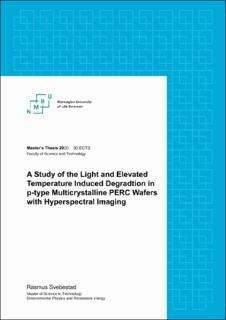| dc.contributor.advisor | Burud, Ingunn | |
| dc.contributor.advisor | Mehl, Torbjørn | |
| dc.contributor.author | Svebestad, Rasmus | |
| dc.date.accessioned | 2020-12-26T21:32:34Z | |
| dc.date.available | 2020-12-26T21:32:34Z | |
| dc.date.issued | 2020 | |
| dc.identifier.uri | https://hdl.handle.net/11250/2720990 | |
| dc.description.abstract | Since 2012 a lot of research has been done to understand the phenomenon of
light and elevated temperature induced degradation (LeTID), which can limit the
efficiency of a solar cell by as much as 20%. In this study LeTID was investigated
by studying samples of multicrystalline p-type passivated emitter and rear cell
(PERC) wafers with hyperspectral imaging. Eight samples were invesigated in
the study. Among these, ve were cut from wafers pre-processed with phosphorus
di usion gettering and hydrogenation (PDGH) while three were cut from wafers
pre-processed with phosphorus di usion gettering (PDG). Samples of di erent
pre-processings were chosen to study the involvement of hydrogen in LeTID. To
study the effect of the placement of a wafer in the ingot, the samples were from
wafers cut from different heights in the ingot. To study LeTID, the samples were
rst pre-processed with an illumination of 0.08 suns with a 1.5 AM spectrum at
room temperature. This was done to mitigate the influence of boron-oxygen light
induced degradation (BO-LID) on the results. Then the samples were treated
with 1 sun of illumination with a 1.5 AM spectrum at a temperature of 110 C to
trigger the LeTID. This treatment lasted more than 300 hours, and throughout
the treatment, hyperspectral images was taken continuously.
It seems clear from the results of this study that hydrogen is participating in the
LeTID, as only hydrogenated samples showed LeTID. From the results it could
be seen that at least one defect were passivated in dislocation clusters of the
hydrogenated samples when the temperature was elevated. This indicates that
hydrogen is activated in the samples when the temperature is raised. The results
of the study indicates that LeTID is disappearing towards the top of the ingot, as
the sample of the wafer from highest in the ingot showed no signs of LeTID. The
most plausible reason for the disappearence of LeTID towards the top of the ingot
is that LeTID is caused by the activated hydrogen passivating the dopant atoms of
the samples. This theory is strengthened by the dislocation cluster of the second
highest hydrogenated sample, which shows increased resiliance towards LeTID. It
seems plausible that this resiliance originates from the hydrogen atoms being more
likely to passivate impurities in the dislocation cluster, rather than passivating the
dopant atoms. LeTID disappearing towards the top of the ingot contradicts the
theory of LeTID being caused by either cobalt or nickel, as the concentration of
these elements increases towards the top of the ingot. | en_US |
| dc.description.abstract | Siden 2012 har det blitt forsket mye for oppnå en økt forst ̊aelse av LeTID, somkan for ̊arsake en degradering på opp mot20 %. I denne studien har prøver avmultikrystalinske p-type PERC wafere blitt undersøkt ved hjelp av hyperspektralebilder for å studere LeTID. Åtte prøver ble brukt i forsøket, og av disse var fempreparert med PDGH behandling og tre preparert med PDG behandling. Grunnentil at både PDG behandlede prøver og PDGH behandlede prøver ble studert varfor å finne ut mer om hydrogens rolle i LeTID. Prøvene ble kuttet ut fra waferetatt fra forskjellige høyder i ingoten, for å studere hvilken effekt dette ville ha påutviklingen av LeTID. Før forsøket begynte ble prøvene bestrålt med et1.5 AMspektrum med styrke på 0.08 sol i romtemperatur. Dette ble gjort for å unngå at resultatene ble påvirket av bor-oksygen degradering som følge av bestrålingen. Dadette var gjort ble prøvene eksponert for stråling med et 1.5 AM spektrum medstyrke på 1 sol, mens de ble varmet opp til omkring110◦C. Denne behandlingenvarte i over 300 timer og det ble tatt hyperspektrale bilder jevnlig underveis.
Det virker klart fra studiens resultater at hydrogen deltar i LeTID. Dette fordi bareprøver som var hydrogenerte viste LeTID. Resultatene viste også at minst en defektble passivert i dislokasjonklustrene til de hydrogenerte prøvene når temperaturen økte. Dette indikerer at hydrogen aktiveres i prøvene når temperaturen øker. Studiens funn tyder også på at wafere hentet fra toppen av ingoten er motstandsdyktige mot LeTID. Den mest sannsynlige forklaringen til dette er at LeTID blir forårsaket av aktiverte hydrogen atomer i waferne som passiverer dopeatomene. Denne teorien styrkes også av at dislokasjonsklusteret fra den nest øverste hydrogenerte prøvenviser en økt motstandsdyktighet mot LeTID, sammenlignet med resten av den prøven. Det virker sannsynlig at denne motstandsdyktigheten skyldes at hydrogenatomer i et dislokasjonkluster vil passivere urenheter fremfor dopeatomer. At LeTID forsvinner mot toppen av ingoten motsier teorien om at LeTID forårsakes av kobolt og/eller nikkel, fordi konsentrasjonen av disse atomtypene minsker mot toppen. | en_US |
| dc.language.iso | eng | en_US |
| dc.publisher | Norwegian University of Life Sciences, Ås | en_US |
| dc.rights | Attribution-NonCommercial-NoDerivatives 4.0 Internasjonal | * |
| dc.rights.uri | http://creativecommons.org/licenses/by-nc-nd/4.0/deed.no | * |
| dc.subject | PV | en_US |
| dc.subject | LeTID | en_US |
| dc.title | A study of the light and elevated temperature induced degradation in p-type multicrystalline PERC wafers with hyperspectral imaging | en_US |
| dc.type | Master thesis | en_US |
| dc.description.version | submittedVersion | en_US |
| dc.subject.nsi | VDP::Matematikk og Naturvitenskap: 400::Fysikk: 430 | en_US |
| dc.source.pagenumber | 88 | en_US |
| dc.description.localcode | M-MF | en_US |

